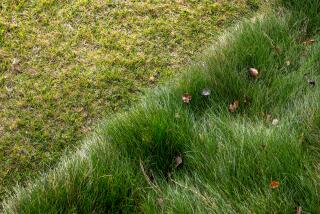Mulch Ado About Edible Landscaping : ADDENDUM
- Share via
The final portion of last week’s article by Kyle Roderick on gardening expert George Patton was inadvertently deleted from the newspaper. What follows is the missing copy.
“An edible landscape,” Patton explains, “needs flowers to help attract pollinating insects for flowering plants such as zucchini, crookneck squash, tomatoes, etc.” Growing diverse vegetables, flowers and herbs also aids in insect control by establishing a habitat for beneficial insects.
When designing an edible landscape, Patton takes special care to group shade-loving plants such as celery, parsley, lettuce and beets near each other. Likewise, sun worshipers such as peppers, tomatoes, eggplants, Swiss chard, radishes and carrots get planted together in their own special zone.
On the subject of watering, Patton is precise. “Plants like to be watered deeply,” he says. “And never water the leaves--this is usually bad for the plant.” Patton installs drip systems and mini-misters in the gardens he designs, but because of water-rationing, Patton recommends mulching with water conservers such as peat moss and newspapers. He says grass clippings, which normally end up in a landfill, can also be recycled into water-saving mulch.
“Gardeners should mulch when they sow a seed bed,” Patton says, “or when a seedling has attained the height of approximately two to four inches. To mulch seed beds, put down one-eighth to one-quarter inch of mulch to keep the soil from crusting. Before mulching, dig a small water-catching basin about four to six inches in diameter and half an inch to one inch deep around each seedling. This will maximize the plant’s water usage. The entire planted area should be thoroughly watered before mulching. And make certain that the proper thickness of mulch is maintained for its highest water-conserving value.”
To mulch with recycled grass clippings, Patton says, “Spread the grass out on the lawn and allow it to dry for one day. Then it’s ready to be gathered and used. Put the mulch no closer than two inches from the actual seedling; this will protect the plant against chewing insects. To maintain the mulch, check to see that the thickness is always at least one to two inches. A mulch generally needs to be reapplied once in a season. If you mulch in the beginning of March, mulch again in July or August, in the peak of summer’s heat.”
To mulch with newspapers, “which is a great recycling move,” Patton observes, “take 10 sheets worth of paper and lay them down so that they overlap a few inches in a single pattern. These should be two inches away from the stem of the plants. To keep them from blowing away, wet them thoroughly and place a little earth over them. They will not need to be moistened with water again. Check newspapers periodically to see if earthworms or other creatures have eaten quite a bit. If they have, additional layers may be needed.”
For mulching with peat moss, Patton offers the following advice: “Since peat moss retains high amounts of moisture, it only needs to be applied in a thickness of one-half to one inch. If earth appears to be peeking through peat moss, then spot-apply more as needed.”
Patton points out that many drought-tolerant, heirloom vegetable varieties are not sold in standard store seed racks. “People interested in getting maximum nutritional value and return on their seed investment should avoid hybrid seeds,” he says, “and instead buy heirloom seeds or traditional seeds such as Hopi blue or pink corn.
“Heirlooms and traditionals offer strong genetics, drought tolerance and long-term yields,” he adds, “whereas hybrid varieties are weaker, crave water and generally put out a burst of growth in a short period of time.”
“Edible landscaping,” Patton says, while raking and turning over the contents of a compost pile, “is a therapeutic activity, and it can be done with minimal investment. Apart from creating a beautiful environment for living things, you’re also feeding yourself. Food can be your medicine both physically and spiritually.”






